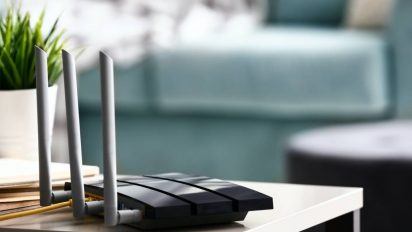“There is an IP address conflict with another system on the network.”
What? Those dreaded words pop up on your PC, inciting confusion and frustration. Conflict? Me? With who? Why? Before you freak out and cue Wanna Be Startin’ Somethin’, let’s start at the beginning, so we understand what’s going on. And then we’ll get to some fairly simple fixes.
For starters, what’s an IP address?
Your IP address is the unique string of numbers, joined by periods, that identifies your device, whether it be a computer, tablet, smartphone, etc. The IP stands for “internet protocol” and it basically allows devices to transmit data back and forth and communicate across networks. So, in short, without IP addresses, data wouldn’t know where to travel over the internet.
It’s kind of like an address and return address on snail mail. With that information, the mail carrier knows not only where to send the information, but where to return it.
When you visit a website, your device gives the website your unique IP address. The IP address includes information about your location and allows the site to send the information you’re requesting to the right location.
Now, onto the Red Alert
One of the most common error messages that pops up when you have an IP address issue is: “There is an IP address conflict with another system on the network.”
So what’s going on? For a system to communicate via a network, it must have a unique IP address. Conflicts arise when two devices are on the same network trying to use the same IP address.
When this occurs, both computers cannot connect to network resources or perform other network operations.
What should you do first?
First, it may sound silly, but try restarting your computer. Yes, sometimes machines simply get “stuck” and need a reboot, and often that will solve this issue.
If that doesn’t help, Microsoft tells us that the best way to solve this issue is to:
- Click Start and select Run.
- Type “cmd” in the box and click OK. A window with a command prompt with an old-school DOS aesthetic appears.
- Type “ipconfig /release” and press Enter. This should release your computer’s current IP addresses.
- Type “ipconfig /renew” and press Enter. This assigns your computer a new set of IP addresses.
- Type Exit and press Enter to close that window.
If that still doesn’t work, an additional method is to change the TCP/IP settings. These settings essentially instruct your computer how to communicate with others.
To do this, Microsoft recommends using automated Dynamic Host Configuration Protocol (DHCP), which automatically assigns IP addresses to your network’s computers.
To enable your DHCP or change your TCP/IP settings:
- Select Start, select Settings > Network & Internet.
- Select Wi-Fi > Manage known networks, if you have a Wi-Fi network. Choose the network you want to change the settings for, and select Properties. (For an Ethernet network, select Ethernet).
- Under IP assignment, select Edit.
- Under Edit IP settings, select Automatic (DHCP) or Manual.
To specify IPv4 settings manually:
- Under Edit IP settings, select Manual, then turn on IPv4.
- To specify an IP address, in the IP address, Subnet prefix length, and Gateway boxes, type the IP address settings.
- To specify a DNS server address, in the Preferred DNS and Alternate DNS boxes, type the addresses of the primary and secondary DNS servers.
To specify IPv6 settings manually:
- Under Edit IP settings, choose Manual, then turn on IPv6.
- To specify an IP address, in the IP address, Subnet prefix length, and Gateway boxes, type the IP address settings.
- To specify a DNS server address, in the Preferred DNS and Alternate DNS boxes, type the addresses of the primary and secondary DNS servers.
- When you select Automatic (DHCP), the IP address settings and DNS server address setting are set automatically by your router or other access point (recommended).
- When you select Manual, you can manually set your IP address settings and DNS server address.
- Select Save.
Still not fixed?
Lucky you. In some rare cases, like if you experience chronic IP conflicts, you may need to update your firmware. At this point, it’s possible that your DHCP server has malfunctioned and assigned two computers identical IP addresses, leading to consistent conflicts. In this case, you’ll want to try to update a driver for hardware that isn’t working properly.
According to Microsoft, it’s best to allow Windows to install device drivers automatically. But if Windows cannot locate your device’s driver, you can do some digging on the manufacturer’s website.
Once you find the updated driver, follow the installation prompts. Some devices are tricky and include drivers you’ll need to install. If you download a driver that isn’t self-installing, try this:
- Make sure you’re logged in as an administrator.
- Open Device Manager. (To get there, click Start, Control Panel, System and Security, Device Manager.)
- In the hardware list, find the device you’d like to update.
- Double click that device’s name.
- Click on the Driver tab.
- Click Update Driver, and then follow the prompts.
You should be all set! Now, if for some reason, you need to change your IP address, we’ve got you covered. For more guidance on internet troubleshooting, be sure to bookmark our Resource Center.
Written by:
Robin LaytonEditor, Broadband Content
Robin Layton is an editor for the broadband marketplace Allconnect. She built her internet industry expertise writing and editing for four years on the site, as well as on Allconnect’s sister site MYMOVE.com. …
Read more

Edited by:
Camryn Smith-
Featured
![403 forbidden error: What it is and how to fix it]() 403 forbidden error: What it is and how to fix it Camryn Smith — 4 min read
403 forbidden error: What it is and how to fix it Camryn Smith — 4 min read -
Featured
![How to find your router IP address]() How to find your router IP address Allconnect — 5 min read
How to find your router IP address Allconnect — 5 min read -
Featured
![What is my IP address and why does it matter?]() What is my IP address and why does it matter? Taylor Gadsden — 4 min read
What is my IP address and why does it matter? Taylor Gadsden — 4 min read
Latest
-
Friday, April 19, 2024
Can other Wi-Fi networks interfere with mine?Robin Layton — 4 min read
-
Thursday, April 18, 2024
Comcast introduces new pre-paid internet, mobile and streaming plansRobin Layton — 2 min read
-
Thursday, April 18, 2024
T-Mobile imposes data cap of 1.2TB/mo.Robin Layton — 2 min read






